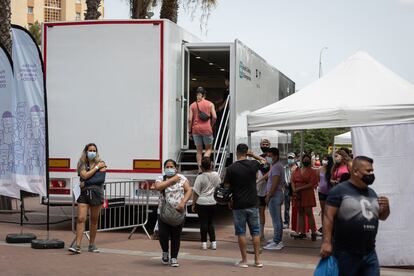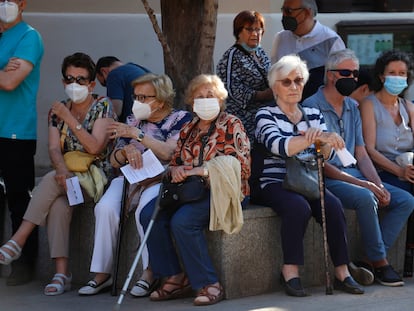Spain hits July target of 25 million people fully vaccinated
The fourth objective set by the government has been met, with 53% of the country’s population now enjoying the full protection offered by the Covid-19 vaccines


Spain has managed to hit the fourth target that was set out by the Spanish government for the national Covid-19 vaccination strategy: end the fourth week of July with 25 million people fully vaccinated against the disease. The Health Ministry confirmed on Thursday that 52.8% of the population – 25,060,958 people – now have the full protection offered by the vaccines being used in Spain. In the midst of a fifth wave of the pandemic, with cases on the rise and the cumulative incidence above 659 cases per 100,000 inhabitants – Spain is now moving on to vaccinate the younger sections of the population, as well as seeking citizens to vaccinate in more vulnerable groups who have slipped through the net.
The Spanish government has met three of the four objectives it set out until now. The only target missed was to reach 15 million people completely vaccinated by June 20 – that date arrived with 560,000 people below the figure. That small delay, however, was soon overcome and the rhythm of the campaign stepped up once more.
The regions are injecting between 500,000 and 700,000 doses a day, and unlike other large European countries Spain is still progressing at a stable or rising pace
Salvador Peiró, an epidemiologist from the Fisabio foundation for health research in Valencia, says that “the vaccination is going as well as it can with the vaccines that are available.” Spain has received nearly 56 million doses since the start of the campaign, and according to the last report from the Health Ministry, the regions have injected 94.6% of them. “Fewer doses are arriving than in June, but it is progressing at a good speed,” the epidemiologist says of the campaign.
In June, Pfizer-BioNTech delivered more doses than expected – some of them had been designated for the fourth quarter of the year – bringing a total of 19 million units to Spain that month, including the other vaccines being used: Oxford-AstraZeneca, Moderna and the one-shot Janssen. In July so far, nearly nine million doses have arrived.
The regions – which are in charge of their healthcare systems, their vaccination programs and their coronavirus restrictions – are injecting between 500,000 and 700,000 doses a day, and unlike other large European countries – such as France, Germany or Italy, where the programs are losing speed – Spain is still progressing at a stable or rising pace.
José Martínez Olmos, a professor from the Andalusian Public Health School, attributes this to there being little hesitancy to the vaccine in Spain. “We are administering the vaccines that arrive given that we have an accessible, universal system, and there is a major willingness among the population to get vaccinated. But that said, we still need to vaccinate the younger population, and although that will undoubtedly move at the same speed, we cannot take it for granted: we have to insist on the benefits of the vaccine.”
Spain is enjoying a summer with the vast majority of its most vulnerable population already protected against the virus. The Spanish strategy prioritized doses for seniors and those with greater risk of suffering serious cases of Covid-19 or dying. Seven months after the first shots were administered, the coverage is nearly complete in the over-70s. Of the 60-69 group, 84.4% are fully protected, while the number rises to 86.5% for the 50- to 59-year-olds.
Even though the vaccines have achieved high levels of protection against serious illness and death in the most vulnerable groups, the primary healthcare system remains overwhelmed
Still to be immunized are the younger age groups, which are currently seeing the virus spread fast among them. A combination of the lack of vaccine coverage and the fact that these groups are more socially active has seen the incidence among the 20-29 group shoot up to 1,863.7 cases per 100,000 inhabitants, and to 1,586.66 for adolescents.
Meanwhile, more than two-thirds of those aged 40-49 are fully protected, while 60% of the 30-39 group has received their first dose. A number of regions in Spain have already opened up the campaign to the 20-29 group and adolescents.
“Vaccinating these groups will work,” argues Peiró. “But the vaccines we administer now will not offer sufficient protection until five weeks have passed. And even less so with the [more infectious] delta variant circulating, for which the first dose offers less protection. This wave needs to be controlled with the classic approach: measures that reduce contacts.”
A number of regions have secured the support of the courts to introduce restrictions that limit fundamental rights, such as curfews or limits on social meetings. Catalonia and Valencia, for example, have restricted nightlife activities, while Aragón, Navarre and Asturias have made similar requests with the courts, according to news agency EFE. In the Balearic Islands, social meetings are banned between 1am and 6am in areas where the cumulative incidence exceeds 450 cases per 100,000 inhabitants, while Murcia has limited social meetings to a maximum of 10 people.
Martínez Olmos points out that there are still large groups of people susceptible to infection and the priority should be to continue vaccinating. In fact, even though the vaccines have achieved high levels of protection against serious illness and death in the most vulnerable groups, the primary healthcare system remains overwhelmed given the rise in new infections and occupation in hospitals has started to rise once more. There are currently 7,618 Covid-19 patients in Spain, of whom 1,240 are in intensive care units (ICUs). This means that 13.5% of available ICU beds are occupied by coronavirus patients, with this figure as high as 40% in Catalonia, where the pressure on the system is greater.
Herd immunity target
The final objective announced by the government is to end the month of August with 70% of the Spanish population fully vaccinated. This percentage was originally considered by experts and the authorities to be the level needed in order to achieve herd immunity – i.e. sufficient coverage among citizens to impede the circulation of the virus.
Epidemiologists consulted by EL PAÍS, however, now believe that 70% will likely be insufficient to stop the pandemic. To start with, the delta variant – which became predominant in Europe in August – is up to 60% more transmissible. “The concept of immunity requires there to be homogeneity for it to take effect,” Martínez Olmos explains. “I doubt that 70% will achieve group immunity. What we need to do is reach 100% of the population that can be vaccinated.”
Peiró agrees, and adds that “the summer is not going to help much” to speed up the vaccinations, and “the high contagion rates are also going to delay vaccine coverage,” given that anyone under 65 has to wait six months after their coronavirus infection before they can be vaccinated.
Experts are calling for people not to drop their guard and for all of those vulnerable groups without protection to be vaccinated. Catalonia, for example, is tackling this problem by sending out buses to parts of the region to reach more people and facilitate access to the system. Epidemiologists recommend that governments be wary of making triumphant announcements. “Messages that the vaccination is moving along really fast reduce the perception of risk,” he argues. “The underlying strategy has to be immunizing as many people via the vaccine, and not by the wild route.”
English version by Simon Hunter.
Tu suscripción se está usando en otro dispositivo
¿Quieres añadir otro usuario a tu suscripción?
Si continúas leyendo en este dispositivo, no se podrá leer en el otro.
FlechaTu suscripción se está usando en otro dispositivo y solo puedes acceder a EL PAÍS desde un dispositivo a la vez.
Si quieres compartir tu cuenta, cambia tu suscripción a la modalidad Premium, así podrás añadir otro usuario. Cada uno accederá con su propia cuenta de email, lo que os permitirá personalizar vuestra experiencia en EL PAÍS.
¿Tienes una suscripción de empresa? Accede aquí para contratar más cuentas.
En el caso de no saber quién está usando tu cuenta, te recomendamos cambiar tu contraseña aquí.
Si decides continuar compartiendo tu cuenta, este mensaje se mostrará en tu dispositivo y en el de la otra persona que está usando tu cuenta de forma indefinida, afectando a tu experiencia de lectura. Puedes consultar aquí los términos y condiciones de la suscripción digital.
More information
Últimas noticias
Maduro pleads not guilty before the federal court in New York: ‘I am still the president of Venezuela’
A new test can detect Alzheimer’s from a finger prick
UN team enters Sudanese city of El Fasher after paramilitary massacre: ‘It’s like a ghost town’
A recipe for resistance: Indigenous peoples politicize their struggles from the kitchen
Most viewed
- Gilles Lipovetsky: ‘If you want to live better and fall in love, take Prozac, don’t look to philosophy’
- Alain Aspect, Nobel laureate in physics: ‘Einstein was so smart that he would have had to recognize quantum entanglement’
- Alvin Hellerstein, a 92-year-old judge appointed by Bill Clinton, to preside over Maduro’s trial in New York
- Maduro’s downfall puts China’s relationship with Venezuela to the test
- Why oil has been at the center of Venezuela-US conflicts for decades









































